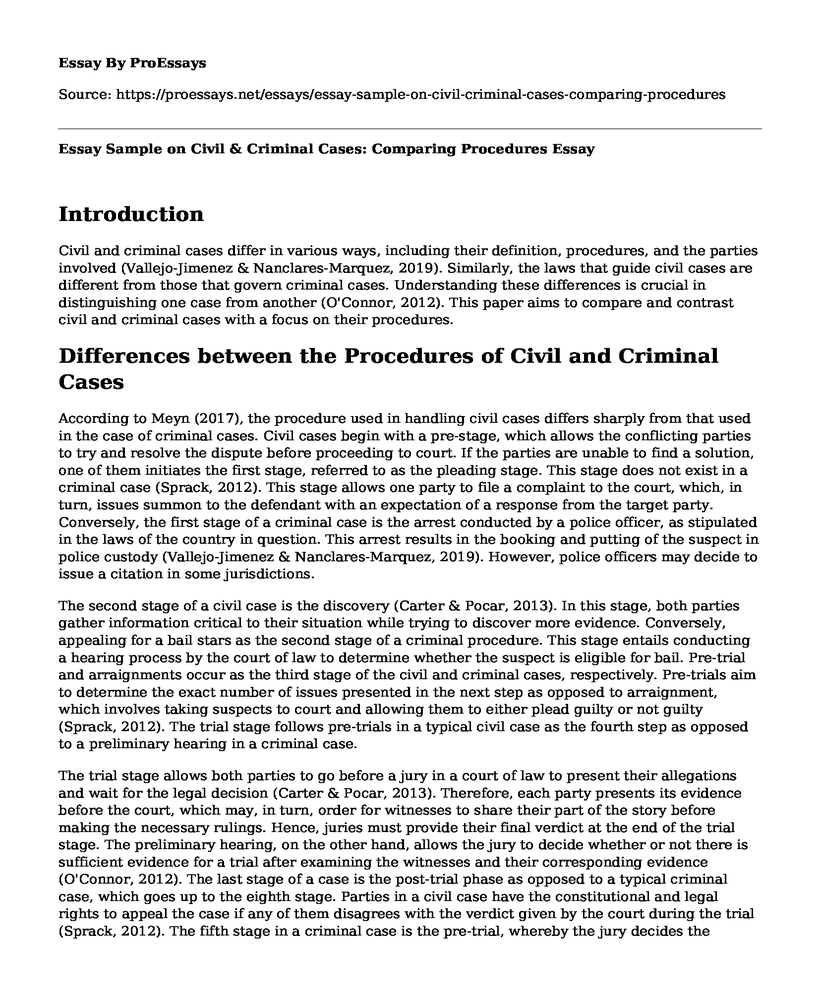Introduction
Civil and criminal cases differ in various ways, including their definition, procedures, and the parties involved (Vallejo-Jimenez & Nanclares-Marquez, 2019). Similarly, the laws that guide civil cases are different from those that govern criminal cases. Understanding these differences is crucial in distinguishing one case from another (O'Connor, 2012). This paper aims to compare and contrast civil and criminal cases with a focus on their procedures.
Differences between the Procedures of Civil and Criminal Cases
According to Meyn (2017), the procedure used in handling civil cases differs sharply from that used in the case of criminal cases. Civil cases begin with a pre-stage, which allows the conflicting parties to try and resolve the dispute before proceeding to court. If the parties are unable to find a solution, one of them initiates the first stage, referred to as the pleading stage. This stage does not exist in a criminal case (Sprack, 2012). This stage allows one party to file a complaint to the court, which, in turn, issues summon to the defendant with an expectation of a response from the target party. Conversely, the first stage of a criminal case is the arrest conducted by a police officer, as stipulated in the laws of the country in question. This arrest results in the booking and putting of the suspect in police custody (Vallejo-Jimenez & Nanclares-Marquez, 2019). However, police officers may decide to issue a citation in some jurisdictions.
The second stage of a civil case is the discovery (Carter & Pocar, 2013). In this stage, both parties gather information critical to their situation while trying to discover more evidence. Conversely, appealing for a bail stars as the second stage of a criminal procedure. This stage entails conducting a hearing process by the court of law to determine whether the suspect is eligible for bail. Pre-trial and arraignments occur as the third stage of the civil and criminal cases, respectively. Pre-trials aim to determine the exact number of issues presented in the next step as opposed to arraignment, which involves taking suspects to court and allowing them to either plead guilty or not guilty (Sprack, 2012). The trial stage follows pre-trials in a typical civil case as the fourth step as opposed to a preliminary hearing in a criminal case.
The trial stage allows both parties to go before a jury in a court of law to present their allegations and wait for the legal decision (Carter & Pocar, 2013). Therefore, each party presents its evidence before the court, which may, in turn, order for witnesses to share their part of the story before making the necessary rulings. Hence, juries must provide their final verdict at the end of the trial stage. The preliminary hearing, on the other hand, allows the jury to decide whether or not there is sufficient evidence for a trial after examining the witnesses and their corresponding evidence (O'Connor, 2012). The last stage of a case is the post-trial phase as opposed to a typical criminal case, which goes up to the eighth stage. Parties in a civil case have the constitutional and legal rights to appeal the case if any of them disagrees with the verdict given by the court during the trial (Sprack, 2012). The fifth stage in a criminal case is the pre-trial, whereby the jury decides the relevant evidence and testimonies before proceeding to its completion at the eighth phase.
Similarities
Remarkable similarities exist between criminal and civil case proceedings (Meyn, 2017). One similarity is that both cases have a trial stage, which allows the judge to listen to the evidence provided by the two conflicting parties to give the appropriate verdict. Also, the two parties can terminate the process if they reach a consensus before the trial stage. Another similarity lies in the events that occur during the trial. For example, judges have the legal right to issue the verdict in both cases (Vallejo-Jimenez & Nanclares-Marquez, 2019). Lastly, the two cases give the parties a chance to appeal if they do not agree with the verdict.
Conclusion
Although civil and criminal cases have differences in their procedures, there are several similarities, especially in the process of the pre-trial and post-trial events. Most of the differences lie in the order and number of stages. However, judges remain with the legal rights to listen to the cases and make the final verdict as the parties decide whether to accept it or not. The law allows either party to file for an appeal for further hearing in case they disagree with the final decision, as discussed in this paper.
References
Carter, L., & Pocar, F. (2013). International criminal procedure: The interface of civil law and common law legal systems. Cheltenham, U.K.: Edward Elgar Publishers Ltd.
Meyn, I. (2017). Why civil and criminal procedure are so different: A forgotten history. Fordham Law Review, 86(2), 697-736. https://ir.lawnet.fordham.edu/cgi/viewcontent.cgi?referer=https://www.google.com/&httpsredir=1&article=5446&context=flr.
O'Connor, V. (2012). Common law and civil law traditions. INPROL-International Network to Promote the Rule of Law, 1(2), 1-35. https://www.fjc.gov/sites/default/files/2015/Common%20and%20Civil%20Law%20Traditions.pdf.
Sprack, J. (2012). Practical approach to criminal procedure. Oxford: Oxford University Press.
Vallejo-Jimenez, G. A. & Nanclares-Marquez, J. (2019). Legal review of the civil, criminal, and administrative consequences of informed consent violation in medical practice. Colombian Journal of Anesthesiology, 47(2), 107-112 https://journals.lww.com/rca/Fulltext/2019/06000/Legal_review_of_the_civil,_criminal,_and.5.aspx.
Cite this page
Essay Sample on Civil & Criminal Cases: Comparing Procedures. (2023, May 22). Retrieved from https://proessays.net/essays/essay-sample-on-civil-criminal-cases-comparing-procedures
If you are the original author of this essay and no longer wish to have it published on the ProEssays website, please click below to request its removal:
- Essay on Havelock Ellis and Sex Psychology
- Research Paper on State Laws
- Save the Children's Foundation - Research Paper
- Case Study on Marcus Dixon
- Essay on Herbert Packer Model: Aiding the Debate on Crime Control and Due Process
- Uncovering the Mystery: Investigating a Murder - Essay Sample
- Essay Example on Mental Health & Gun Violence: Connecting the Dots







